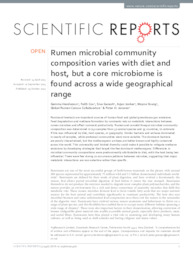Rumen microbial community composition varies with diet and host, but a core microbiome is found across a wide geographical range.
Rumen microbial community composition varies with diet and host, but a core microbiome is found across a wide geographical range.
Author(s): HENDERSON, G.; COX, F.; GANESH, S.; JONKER, A.; YOUNG, W.; GLOBAL RUMEN CENSUS COLLABORATORS; JANSSEN, P. H.
Summary: Ruminant livestock are important sources of human food and global greenhouse gas emissions. Feed degradation and methane formation by ruminants rely on metabolic interactions between rumen microbes and affect ruminant productivity. Rumen and camelid foregut microbial community composition was determined in 742 samples from 32 animal species and 35 countries, to estimate if this was influenced by diet, host species, or geography. Similar bacteria and archaea dominated in nearly all samples, while protozoal communities were more variable. The dominant bacteria are poorly characterised, but the methanogenic archaea are better known and highly conserved across the world. This universality and limited diversity could make it possible to mitigate methane emissions by developing strategies that target the few dominant methanogens. Differences in microbial community compositions were predominantly attributable to diet, with the host being less influential. There were few strong co-occurrence patterns between microbes, suggesting that major metabolic interactions are non-selective rather than specific.
Publication year: 2015
Types of publication: Journal article
Unit: Embrapa Dairy Cattle
Keywords: Metabolism of ruminant, Ruminant digestion
Observation
Some of Embrapa's publications are published as ePub files. To read them, use or download one of the following free software options to your computer or mobile device. Android: Google Play Books; IOS: iBooks; Windows and Linux: Calibre.
Access other publications
Access the Agricultural Research Database (BDPA) to consult Embrapa's full library collection and records.
Visit Embrapa Bookstore to purchase books and other publications sold by Embrapa.

